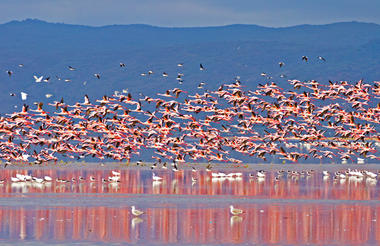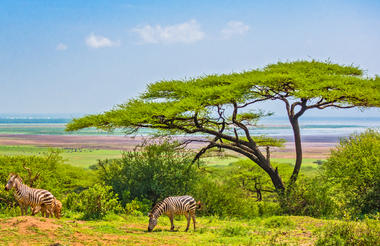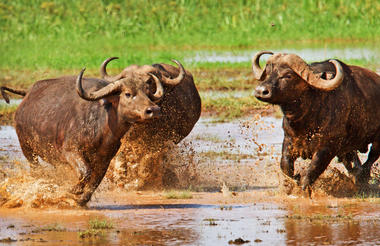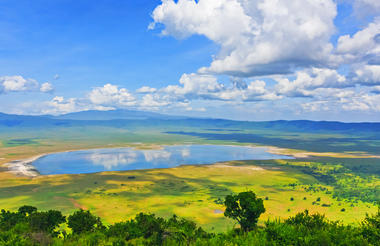Lake Manyara National Park is famous for its tree-climbing lions, who spend most of the day spread out along the branches of Acacia trees six to seven metres above the ground. Nestled at the base of the Great Rift Valley escarpment, the park is noted for its incredible beauty. As visitors enter the gate, they pass into the lush forest, home to troops of baboons and both blue and vervet monkeys. Further along, the forest opens up into woodlands, grassland, swamps and beyond the soda lake itself, covering 200 square kilometres and sanctuary to over 400 species of bird including flamingo, pelican, stork, sacred ibis, cormorant and Egyptian Geese. The park is particularly noted for its huge herds of buffalo and elephant, as well as giraffe, hippo, reedbuck, warthog, wildebeest, zebra and a great variety of smaller animals.



Situated in the East African country of Tanzania, Lake Natron is fed by mineral-rich hot springs and is less than three meters deep. High levels of evaporation leave loads of salt and minerals behind, the volcanic carbonate colours the water a striking red and the temperature can reach up to 50 degrees Celsius. All of which makes it a perfect breeding ground for the endangered Lesser Flamingo; however, it is known as the deadliest lake in the country, the high sodium carbonate level in the water is known to calcify and petrify wildlife who get too close. Visitors can climb the Ol Doinyo L'Engai, an active volcano; explore the surrounding terrain, including rugged mountains, grassy plains, and gorges; and spot a variety of wildlife.



The northern Serengeti stuns with rolling hills, lush riverine forests and dramatic granite outcrops. It’s the hotspot from July to October, when wildebeest and zebras charge across the Mara River in epic crossings. But don’t get obsessed with just the crossings—this beautiful part of the park is packed with wildlife! From elephants and buffalo to leopard, zebra, eland and gazelle, there’s plenty to see. Birdwatching is a treat both around the camp and on game drives, and don’t miss a balloon safari for a breathtaking view.



The Seronera region, in the central Serengeti, is set directly on the Great Migration route, and offers excellent viewing of this incredible annual phenomenon, when countless wildebeest flood across the plains. While migratory game populations fluctuate seasonally, Seronera is still a wildlife hotspot at other times of the year, sheltering the Big Five, among many other species. Visitors can enjoy hot air balloon trips and walking safaris as well as guided game drives.



The Ngorongoro Crater is the largest unbroken caldera in the world. Surrounded by very steep walls rising 610 metres from the crater floor, this natural amphitheatre measures 19.2 kilometres in diameter and 304²km in area. It is home to up to 30,000 animals, almost half of which are wildebeest and zebra. Buffalo, elephant, hippo, hyena, jackal, lion, ostrich, serval, warthog, bushbuck, eland, hartebeest, reedbuck, waterbuck and huge herds of both Thomson’s and Grant’s gazelle are easily seen on the crater floor.







